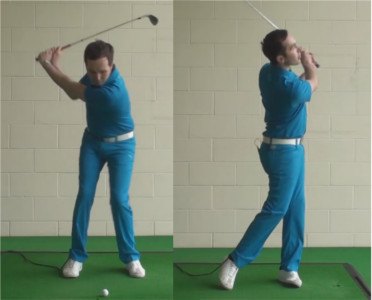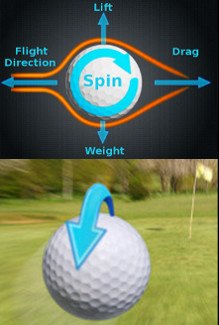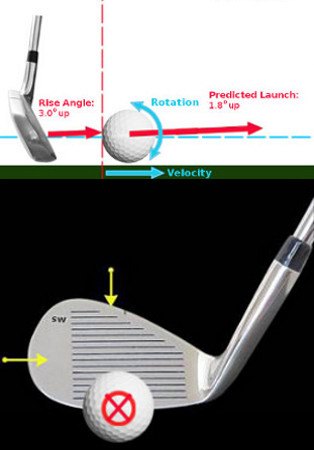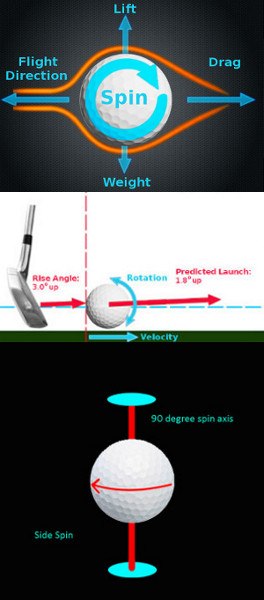
Watching a golf ball landing on the green, past the pin and having the backspin to make the golf ball come back towards the flag with control and precision is a shot most amateurs dream of. Even the desire to make the golf ball stop on the green as quickly as possible is something golfers wish for. This tip will help you create more backspin than you have created before.
The secret to creating more backspin whilst hitting irons and wedges into the green is the preparation and circumstances of the shot in hand.
Important points to create more backspin
- Clean golf clubs and sharp grooves are vital when attempting to create more backspin. Debris and dirt in the groves affect how much the grooves grab on to the golf ball, therefore affecting how much spin is generated. Sharp grooves are also a vital aspect to create greater backspin. If the grooves are sharp, the edges can bite into the golf ball grabbing the cover of the ball to create more backspin.
- The golf ball's quality is also a crucial aspect when attempting to create backspin. Ideally, the golf ball cover needs to be soft enough for the grooves of the golf club to bite into it to create the backspin that is needed. If the golf ball cover is too hard, the grooves will struggle to grab the ball, making it spin on the club face.
- A quality strike is one of the most important factors when creating backspin. Ideally, the golf ball needs to be struck first then the turf after creating a downward blow that continues through the surface to create a divot beyond the golf ball.
- Confident acceleration through impact is imperative to create the speed that the golf club needs to create maximum backspin on the golf ball. Always make sure when looking to create backspin that the shot is hit with 100% confidence and commitment.
- The playing surface needs to be correct when looking for maximum backspin. The surface that you are hitting from and the surface you are hitting into have to be in good condition to create maximum backspin on the golf ball. The surface you are hitting from ideally needs to be a fairway surface or short grass. This will maximize the likeness of creating a perfect strike on the golf ball to create the best possible amount of backspin. If the grass is too long, there is a much greater chance of trapping some grass between the club face and the golf ball affecting the strike quality. The green you are hitting into ideally wants to be a receptive one so that the ball leaves a pitch mark and is a fast green to maximize the ball speed when the golf ball lands with a great deal of backspin.

Key tip - All the above factors will maximize the amount of backspin you create, however backspin can and will still be achievable with only a few of the above important factors in place.

How Do I Create Backspin on a Golf Ball?
Golf is a game that is all about spin. That might be news to some beginning golfers, but it is the truth. Learning how to control the golf ball around the course means learning how to control spin – there is no way around that fact. Of course, you can't see the spin on the ball as it flies through the air, but it is always there. Every single golf shot hit throughout the course of each round you play is going to have spin, and it is your job to use that spin to your benefit. When you are able to reliably predict what kind of spin you are going to put on your shots, you can consistently get the ball close to the hole. Of course, if you struggle to control that spin, it will be a challenge just to keep the ball in play.
Creating backspin is something that most new golfers want to learn how to do right away. They have seen professional golfers on TV spinning the ball back dramatically on the green and they want to do the same. However, there is more to backspin than just being able to back up a wedge shot. The backspin you put on the ball is important for the purposes of keeping your shots in the air for as long as possible, as it is the spin that gives your shots lift. Also, a healthy backspin rate is helpful for bringing your longer shots down softly, enabling them to stay closer to where they land and giving you more control over your game. As long as you can control it, there is very little negative you can say about backspin on golf shots.
Unfortunately, most amateur golfers do not understand how to create backspin properly. There are plenty of misconceptions about backspin and how it is produced, and that misinformation leads millions of golfers to swing the club improperly. This is a case where knowledge is definitely power – once you understand how the club should be used through impact to create spin, you will have a better chance of making a proper swing. Take the time to read through this article to understand exactly how backspin is generated and you will almost certainly be a better golfer in the end.
As you are learning about backspin, it is important to remember that you don't want to ruin the rest of your swing technique just to add a bit more spin to your shots. Yes, backspin is important, but it is not the only thing that you should be focused on during the swing. A fundamentally-sound swing will deliver the club into the ball in a way that allows backspin to be created while also providing plenty of power, control, and more. If you change everything about your swing just to ramp up the amount of spin you generate, the results are likely to be disappointing.
All of the instruction below is based on a right handed golfer. If you happen to play left handed, please be sure to reverse the directions as necessary.

The Spin Equation
While it can seem like some form of 'magic' when done by a professional golfer, putting backspin on the golf ball is actually quite simple. When the ball is compressed against the face of the club at impact, it will 'roll' up the face slightly as it leaves – and backspin will be created. Of course, the ball is going to move up the face of a higher lofted club such as a wedge much quicker than it will a club like the driver, which is why short iron shots have such high rates of spin as they take off into the sky. When clean contact is made with the ball, backspin is inevitable. The only question is how much spin will be created, and how much sidespin there will be to go along with the backspin.
You can't talk about backspin in golf without talking about sidespin as well, because the two are inevitably linked. True backspin without any sidespin is nearly impossible to achieve, as almost every golf shot you will ever play is going to have at least a little bit of sidespin as it flies through the air. Shots with a little sidespin will only curve slightly on their way to the target, while shots with a high rate of sidespin will curve wildly out of control. In addition to managing how much backspin you put on your shots at impact, you also need to have the ability to control your sidespin if you are going to play consistent golf.
So, it's pretty simple then, right? You just rip the club through the ball at impact, backspin is created, and the ball stops almost immediately when it lands? Well, it's not quite that easy. Golf is a complicated game, and there are plenty of complicating factors which come together to make it a little bit harder than you might think to regularly use backspin effectively. Below is just a partial list of the various elements that have an effect on how much spin you are going to be able to put on the ball.
- The lie. This is the major variable that you are going to have to consider when playing shots throughout a given round. If you don't have a great lie – meaning there is going to be grass between the face of the club and the ball at impact – you will have trouble getting much backspin on the shot. Playing from the rough is so difficult in large part because you lose the ability to spin your shots as you would normally from the fairway. Have you ever seen a shot coming in out of the rough take a huge bounce when it lands on the green? That is because of the grass that is stuck between the face and the ball at impact. Learning how to read your lie to determine how much spin you are going to get is a crucial skill.
- The club. Are you using new clubs, or are your clubs starting to show the signs of age? New clubs have new grooves, and new grooves make it much easier to spin the ball. When your clubs start to wear out and your grooves begin to get a bit thin, you will notice that it becomes much more difficult to impart a healthy spin rate on your shots. While you don't always want to buy new equipment in an effort to improve your game, buying some fresh irons and wedges when your old ones begin to wear out is a smart move.
- The ball. The ball that you choose to use will have a profound impact on the amount of spin that is carried on the shot. Generally speaking, a soft golf ball with three or four layers is going to spin at a relatively high rate, while a ball with just two layers will feel harder and won't spin much at all. Beginners often use two piece balls because they are less expensive and the lower spin rates help them keep the ball on the course. As you gain experience, you can move into a three or four piece ball to add spin – although these types of golf balls are more expensive to purchase.
As you can see, there is a lot that goes into the spin rate that you are going to achieve. The three points above each play a big role in this equation, and those points don't even include swing speed, which is another big variable. Swinging faster will typically put more backspin on the golf ball, all other things being equal. At this point, you should begin to have a good understanding for why it is so difficult to predict exactly how much spin you are going to put on a given shot. Accomplished players are able to regularly 'guess right' when it comes to backspin, but that skill takes years of experience and a highly repeatable golf swing.

Improving Your Spin Rate
Very likely, you are reading this article because you want to put more spin on the golf ball. If that is the case, you can benefit from a collection of basic tips that will help you to move the club through impact in a way that is likely to result in a healthy backspin rate. Of course, as was mentioned earlier, backspin is only one of many important pieces of the golf puzzle, so don't lose track of the rest of your game in a desperate effort to add spin. Only when you can pick up spin without harming the rest of your swing will you really be able to make good progress.
If you would like to work on hitting shots with more backspin during your next practice session, consider the tips listed below.
- Hit down more aggressively. This is the point that you probably think of first when you consider adding spin to the ball. It is no secret that hitting down is the best way to add backspin, as moving the club downward through the ball will give the ball an opportunity to 'roll' up the clubface and collect backspin before it leaves. Of course, you don't want to hit down too steeply, as that would lead you to taking too much turf and possibly hurting yourself in the process. To hit down from a reasonable angle, try to stay nicely balanced during the backswing before driving toward the target with your lower body on the way through. An aggressive move with your lower body will bring your center of gravity slightly left on the way down, leading to a downward hit and plenty of backspin (assuming you make clean contact). This is a great way to swing with your mid and short irons, although you will want to flatten things out a bit when you get up into the long irons and woods. For example, you don't want to hit down on your driver at all, but rather you should be hitting up slightly at impact to create a powerful launch.
- Hit the sweet spot more often. This is a point that is regularly overlooked by golfers trying to improve. If you would like to spin the ball at a higher rate, one of the best things you can do is simply to hit the sweet spot more regularly. Rather than contacting the ball in off the toe or out toward the heel, focus on catching your shots right in the middle of the face. Most golfers try to swing harder when they want plenty of backspin – and that can help – but the better way to go is simply to focus your attention on a clean hit. If you can hit the sweet spot while hitting down slightly from above, you are going to get plenty of spin on your shots to get around nearly any course.
- Pick the right ball. This was mentioned previously, but it needs to be highlighted again due to the importance of the point. If you are going to maximize your spin rate as effectively as possible, you need to be playing a golf ball that matches with your skills. That doesn't mean you automatically need to play the most expensive ball on the shelf – in fact, the most expensive ball is unlikely to be the best fit for you, as those golf balls are designed to perform well for the players at the top of the game. Most likely, if you are an 'average' golfer who shoots in the 80's or 90's, you will want to buy a mid-level ball for somewhere around $20 - $30 per dozen. This range of balls offers a nice blend of spin and durability, so you should be able to get a good return for your purchase.
If you can hit down on the golf ball, make contact on the sweet spot, and always use the right ball for your game, you should be in position to get plenty of backspin on your shots. Even if you aren't spinning the ball back on the greens like a professional golfer, you will still have enough spin to stop your shots and set up (hopefully) birdie putts.

When Backspin is the Enemy
So far, we have talked exclusively about all of the good things that backspin can do for your game. However, backspin is not always a good thing, as there are certain times that a high backspin rate can get you into trouble. With that in mind, it is helpful to have the ability to hit shots with lower spin rates from time to time depending on the situation. The following scenarios are all times when you may want to lower the rate of spin that you put on the ball.
- Playing in the wind. Backspin helps you to hit the ball high, but hitting the ball high in the wind is the last thing you want to do. Instead, you want to keep the ball as close to the ground as possible in order to avoid having the wind blow your shots in undesired directions. Many golfers think they only need to keep the ball down when they are playing into the wind, but you actually want to play low shots regardless of wind direction. With less spin, your shots will fly lower and the wind will be less of a factor.
- Soft greens. If you are playing on a course with soft greens (usually due to rain), you may need to take some of the spin off of your shots in order to keep the ball on the putting surface after it lands. The combination of soft greens and high spinning approach shots is a dangerous mix, as you may watch as your ball spins back off the front of the green and back down into the fairway. When greens are soft and you are playing short approach shots, taking spin off the ball becomes a necessity.
- Back hole location. When trying to get the ball close to a hole location that is cut in the back of a green, you will want to take some spin off in order to permit a larger first bounce and roll. Flying the ball all the way back to the hole location is a dangerous game, as hitting the shot just a bit too far could lead to big trouble over the green. Instead, take some spin off the shot and play it to the center of the green where it can then bounce back to the hole.
So, as you can see, there are plenty of occasions where you would benefit from being able to take some spin off the ball. To do so, you are going to need to make just a couple of adjustments to your regular swing. First, you are going to swing softer than you would normally when hitting a full shot. Taking speed out of the swing will reduce the spin rate, so hit one extra club and swing softer to lower the spin and bring the flight down. The other adjustment that needs to be made is choking down on the club by an inch or two. Coming down on the grip will also take some speed out of the swing, and it will naturally lower your flight as well.
Naturally, you will need to practice these lower spin shots if you are going to have success with them on the course. Make it a point to hit at least a few low spin shots during each practice session and you will soon become comfortable with producing this kind of shot.

Spin in the Short Game
You will not only want to be able to take advantage of backspin in the long game, but in the short game as well. Specifically, you want to be able to spin your pitch shots as well as your bunker shots from around the green. Spin in the short game is all about control. Getting the ball to stop in time is important when playing short game shots, and spin is the more powerful weapon you have at your disposal to stop the ball. Learn how to impart spin on the short shots you play from near the green and your short game will quickly and dramatically improve.
Fortunately, not much changes from the long game to the short game with regard to spin. You still need to hit down, you still need to hit the sweet spot, and you still need to have a good lie. Also, playing a relatively soft golf ball is going to help in this pursuit as well. In many ways, you will want to think of your short game shots as miniature versions of your full swing.
The most important point to remember with regard to short game shots that you wish to spin is the fact that you need to accelerate the club all the way through impact. Many golfers slow down as they reach the ball to avoid hitting the shot too far, and they lose out on the possibility of spin as a result. Don't make that mistake. You have to be committed to spinning your pitch shots in order to actually make it happen. Make a tight backswing on your chip and pitch shots, accelerate the club confidently through the hitting area, and look for plenty of spin when the ball lands on the green.
Backspin is a big part of the game of golf. As you work toward elevating your overall level of play on the course, working on your ability to spin the ball on command is an important step. You don't have to be able to spin it at the same rate as the players on the PGA Tour, but you still want to be able to produce enough spin to control your ball and stop it effectively on the greens. Use the information contained in the article above to get on a path toward better spin rates in the near future.






